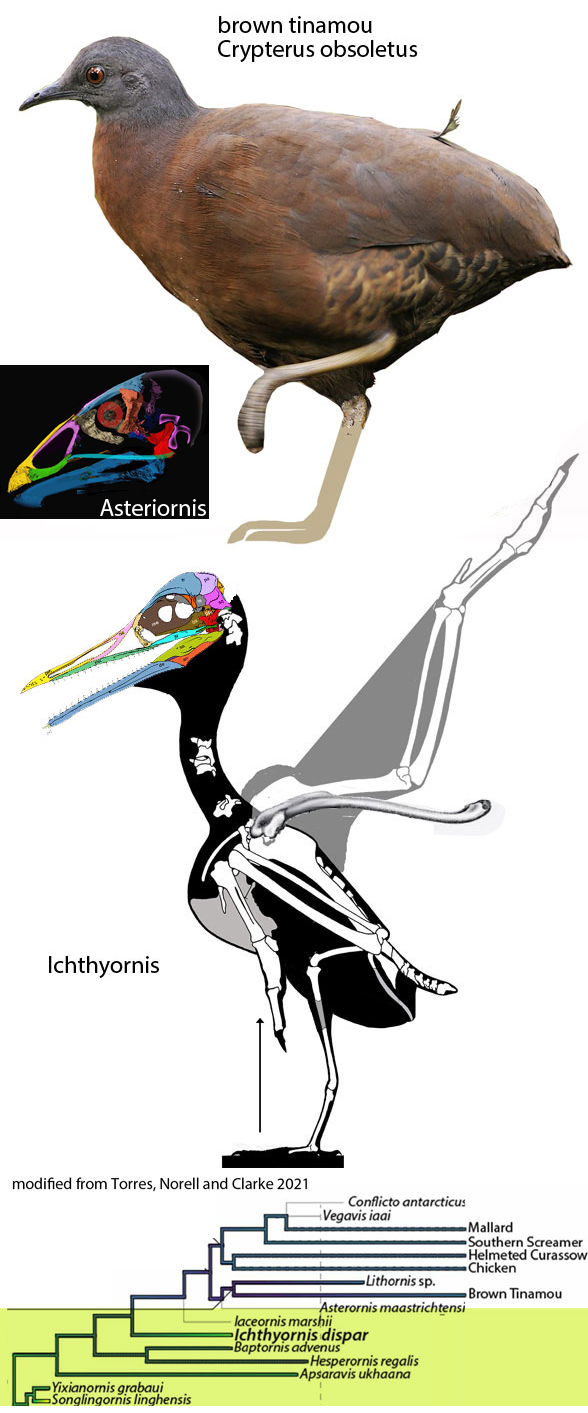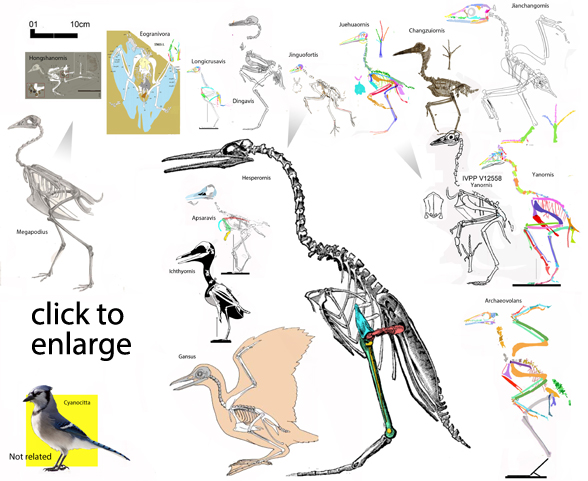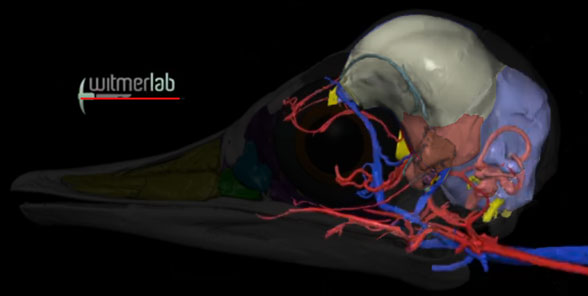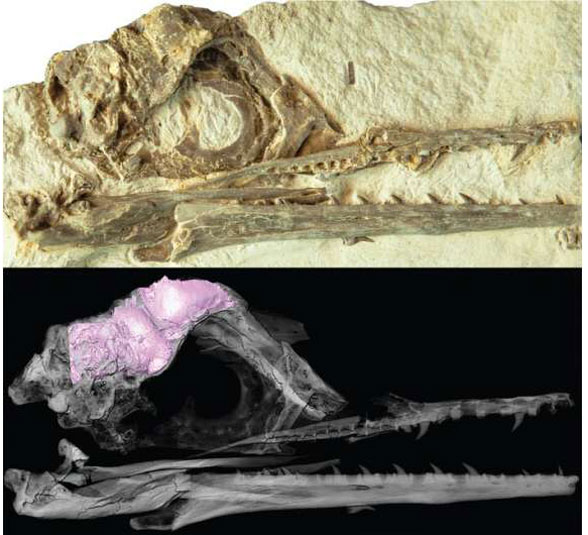There’s a better answer to that question.
See below.
While we’re on this subject,
let’s put a magnifying glass on the cladogram published by the authors (Fig. 2).
Torres, Norell and Clarke 2021 report on
bird neurocranial and body mass evolution across the end-Cretaceous mass extinction. According to Torres, “Bird brains left other dinosaurs behind.” The authors studied the small brain of Ichthyornis (Figs. 1, 2) which they considered THE proximal ancestor to crown birds (Fig. 2). On the other side of the K-T event, THE basalmost crown bird in Torres, Norell and Clarke is represented by the “Brown Tinamou” (Crypterus obsoletus, Fig. 2) nesting with the Latest Cretaceous goose, Asteriornis (which lacks a cranium).
Take a comparative look
at Ichthyornis, Asteriornis and the brown tinamou (Fig. 2). It should be easy to see that these three taxa are not closely related whether in morphology, diet or niche.
The ichthyornithid, Iaceornis, lacks a skull, but Torres, Norell and Clarke chose to include it, if tentatively. This would have been okay to delete since it adds no data to the brain question.
For reasons hard to understand, but easy to see,
the Torres, Norell and Clarke cladogram has some messy (= illogical, not gradual) branches, especially at the crucial K-T node (Fig. 2).

Torres et al. 2021 write,
“Traits hypothesized to explain differential patterns of dinosaur survivorship of the Cretaceous-Paleogene (K-Pg) mass extinction include aspects of neuroanatomy and feeding ecology. Extant birds (Aves) have brains with relative volumes and neuronal densities that surpass all other reptiles. These traits may have provided a selective advantage over other dinosaurs in the face of rapidly changing environmental conditions at the K-Pg boundary.”

This issue, like all issues, also has to be put into a valid phylogenetic context.
The basalmost birds that survived the K-T event, the last common ancestors of all crown birds, in the large reptile tree (LRT, 1890+ taxa; subset Fig. 4) are the extant kiwi (Apteryx) and its longer legged, Paleocene, extinct sister, Pseudocrypturus, (close to Lithornis) followed by megapodes and ratites. These all have larger brains than Ichthyornis (Fig. 2).
The kicker is,
in the LRT (Fig. 4), Ichthyornis is ALSO an extinct crown bird, derived from Cretaceous crown-group megapodes (Fig. 5). In the LRT Ichthyornis is not a stem bird outgroup taxon.

Torres et al. 2021 write,
“If a feature of the brain affected survivorship, we would expect it to be present in the survivors but absent in the casualties, like Ichthyornis,” said Torres. “That’s exactly what we see here.”
Don’t jump to conclusions, especially with regards to one trait and without a valid phylogenetic context (= validated by a gradual accumulation of traits at every node).

Torres et al. did not realize
their error because their phylogenetic context was flawed, perhaps due to some bad scoring. They erroneously considered Ichthyornis “a toothed stem bird” that “has traditionally been considered the nearest known well-understood relative of extant birds.”
Never rely on tradition. That’s the easy way out and it is fraught with the possibility of error. Always work within a valid phylogenetic context in which all taxa document a gradual accumulation of traits. In the LRT, Ichthyornis and Asteriornis are not transitional taxa, but dead-end taxa, leaving no descendants. Professionals should have a good cladogram in their digital library at all times. Torres, Norell and Clarke should have looked at what their results recovered (Fig. 2) to realize their error.

Taxa just prior to crown birds
include only one taxon that preserves the skull, Cratoavis, and it appears to have a small cranium relative to the orbit and the rest of the skull. Even so, evolution does not work in a small brain to big brain direction. The brain size can vary. Poor Ichthyornis had a smaller brain than its ancestors among the toothless megapodes (Figs. 4, 5).
Considering the searing temperatures experienced
by the Earth and its birds at the K-T extinction event, having a larger brain would not have helped. Distance and geography must have produced bird refugia. That was a more likely animal protector from the ravages of that day and the years that followed. Only surviving populations produced Tertiary birds, including Paleocene penguins in far off New Zealand. Toucans in South America and hornbills in Africa separated long before the K-T event, yet both found refuge, somehow. So did the elephant bird on Madagascar.
The authors report,
“Ichthyornis exhibited a wulst and segmented palate, previously proposed to have arisen within extant birds.” That’s because Ichthyornis IS a crown bird, as first documented in the LRT. So this bit of data does not come as a surprise, but validates the LRT.
The authors report,
“We reinvestigate phylogenetic relationships within Avialae using a matrix of 223 morphological
characters scored for 43 avian and non-avian birds.”
This report needed many more taxa (Fig. 4) including a few more Solnhofen birds.
References
Torres CR, Norell MA and Clarke JA 2021. Bird neurocranial and body mass evolution across the end-Cretaceous mass extinction: The avian brain shape left other dinosaurs behind, Science Advances (2021). DOI: 10.1126/sciadv.abg7099
people.ohio.edu/witmerl/3D_ostrich.htm
sciencetimes.com/articles/30297/20210325/extinct-bird-pre-historic-skull-brain.htm
phys.org/news/2021-07-bird-brains-left-dinosaurs.html
Video link added March 17, 2022


Isn’t Asteriornis known exclusively FROM a skull/cranium? I wouldn’t quite say it lacks one.
Shown in the figure above, I had to estimate a cranium. The rest of the skull is there.
Ah, I see. I forgot “cranium” referred to the posteriormost half of the skull.